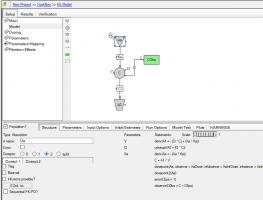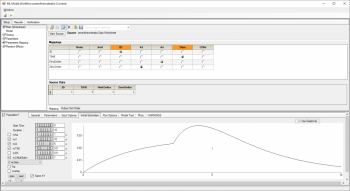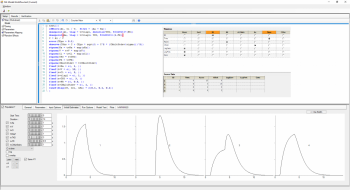Edited by Davidq8, 13 February 2022 - 05:46 AM.

Sequential zero order followed by first order absorption
#1

Posted 13 February 2022 - 03:48 AM
#3

Posted 13 February 2022 - 02:16 PM
try a simpler model first
#5

Posted 15 February 2022 - 11:50 PM
try a simpler model first
test(){cfMicro(A1, Cl / V, first = (Aa = Ka))dosepoint(A1, duration=TK0, bioavail=(FR))dosepoint(Aa, tlag = TK0, bioavail=(1-FR))C = A1 / Verror(CEps = 0.1)observe(CObs = C + CEps * sqrt(1 + C^2 * (CMultStdev/sigma())^2))stparm(Ka = tvKa * exp(nKa))stparm(V = tvV * exp(nV))stparm(Cl = tvCl * exp(nCl))stparm(TK0 = tvTK0)stparm(FR = tvFR)stparm(CMultStdev = tvCMultStdev)fixef(tvKa = c(, 1, ))fixef(tvV = c(, 10, ))fixef(tvCl = c(, 5, ))fixef(tvTK0 = c(, 3, ))fixef(tvFR = c(, 0.5, ))fixef(tvCMultStdev = c(, 1, ))ranef(diag(nV, nCl, nKa) = c(0.1, 0.1, 0.1))}make sure that you enter the same dose amount into Aa and A1 then total dose into system =A1*FR + (1-FR) *Aa =make sure that tlag = tk0dosepoint(A1, duration=TK0, bioavail=(FR))dosepoint(Aa, tlag = TK0, bioavail=(1-FR))
Thanks, Sameer, for having time correcting the codes for my analysis.
#6

Posted 15 February 2022 - 11:55 PM
I have another question. How about if we have changed the absorption scenario to simultaneous where both zero and first order are happing at the same time. I am not sure if the following model describes the process correctly:
test(){
cfMicro(A1, Cl / V, first = (Aa = Ka))
dosepoint(Aa, tlag = Tlag,duration = TK0 )
C = A1 / V
error(CEps = 0.1)
observe(CObs = C + CEps * sqrt(1 + C^2 * (CMultStdev/sigma())^2))
stparm(Ka = tvKa * exp(nKa))
stparm(V = tvV * exp(nV))
stparm(Cl = tvCl * exp(nCl))
stparm(TK0 = tvTK0)
stparm(CMultStdev = tvCMultStdev)
fixef(tvKa = c(, 1, ))
fixef(tvV = c(, 10, ))
fixef(tvCl = c(, 5, ))
fixef(tvTK0 = c(, 3, ))
fixef(tvCMultStdev = c(, 1, ))
ranef(diag(nV, nCl, nKa) = c(0.1, 0.1, 0.1))
}
#7

Posted 16 February 2022 - 07:27 AM
#8

Posted 16 February 2022 - 05:03 PM
yes you can have tlag different than tk0 and then both can happen at the same timeyou can have a lag affecting both or just the first order and then if tvlag < tk0 thendosepoint(A1, duration=TK0, bioavail=(FR))dosepoint(Aa, tlag = tvlag, bioavail=(1-FR))you still need two dosepoint if you want simultaneous absorption ( there is more advanced options where dosepoint can split a dose automatically but for now stick to the abovedosepoint(Aa, tlag = Tlag,duration = TK0 )this line is saying we have a tlag after which the dose enter the Aa absorption compartment using a TK0then from Aa to A1 we have a first order process using a KAcfMicro(A1, Cl / V, first = (Aa = Ka))
Thanks, Samer for clarifying the point regarding simultaneous absorption model, but I have a question about Tlag
so if we add two lag time for both absorption zero and the first, let assume the Tlag for the zero order will be Tlag1
and the codes lines will be like this:
dosepoint(A1, duration=TK0, bioavail=(FR))
stparm(Tlag = tvTlag * exp(nTlag))
Now, time lag for the first order absorption (Tlag2) will be Tlag2= Tlag (for zero order) + TK0 (duration).
My question how we write codes line for Tlag 2?
Thanks
#9

Posted 17 February 2022 - 07:33 AM
Attached Files
#10

Posted 17 February 2022 - 07:37 AM
you can just tell the pml what you want:
if for Aa tlag = Tlag1 + TK0then no need to have a separate line for it it is a sum of two already defined parameter
stparm(Tlag1= tvtlag1* exp(nTlag1))
stparm(Tlag2 = tvtlag1 * exp(nTlag2))
estimating n on lag and have multiple of those can render you model pretty unsolvable
#11

Posted 17 February 2022 - 07:52 PM
Thanks, Sameer, for your time answering all of my questions regarding mixed absorption scenarios. All of your answers helped me to understand the concepts better. I believe combined absorption, in general, gives a better fit than Tlag alone, and it could be a possible alternative to the transit compartment that has a downside which is the long running time needed especially if you have a complex model or computer system with limited computational power.
Edited by Davidq8, 17 February 2022 - 07:53 PM.
0 user(s) are reading this topic
0 members, 0 guests, 0 anonymous users

















